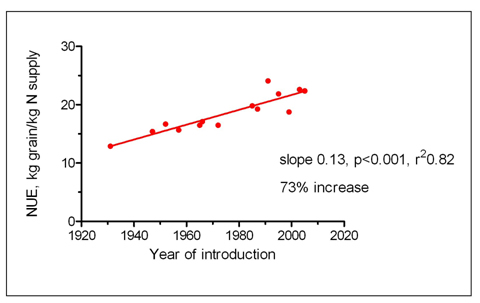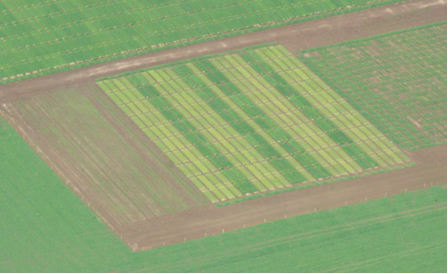Plant breeding has increased the nitrogen use efficiency of barley varieties
Published on 7 February 2011 in Sustainability and Communities
Introduction
Nitrogen (N) is an essential element in the growth and development of crops. Poor access to N fertilizer is a major limitation to crop productivity in some developing countries, whilst in other more affluent countries increased productivity over recent decades has been associated with a substantial increase in N fertilizer use. However, high N-fertilizer use is also environmentally damaging. Approximately half the energy costs of cereal production are associated with the manufacture and transport of inorganic N-fertilizer. Cereal crops are inherently inefficient in their use of N with only around 33% of the N available to the crop being recovered in the grain. Excess N may be lost from the soil by leaching or surface run-off to water courses or by gaseous emissions (including ammonia and nitrous oxide) contributing to eutrophication and global warming. It is now widely recognised that nitrogen use efficiency (NUE) must be improved so that cereal yields can be increased to meet the growing global demand, but with reduced inputs of fertilizer.
Two complementary approaches to this problem are possible: a) to improve agronomic practice and N management strategies and b) to increase the NUE of new varieties. The latter approach requires information on which phenotypic (morphological and physiological) traits govern NUE, and the extent of variation in these traits within the breeding population. To date barley breeding has focussed mostly on the improvement of grain yield and quality characteristics. A retrospective analysis of the effects of this breeding on NUE is useful for identifying traits associated with NUE and whether there is scope for future improvement.

Fig. 1 NUE of spring barley varieties differing in date of commercial introduction
Key Points
- Breeding of spring barley for yield over the last 75 years has resulted in an increase in NUE. Thus modern high yielding varieties are more efficient in their use of N (greater grain yield per unit of N available from fertilizer and mineralisation of soil organic matter) than old varieties (Fig. 1). The improvement represents about a 1% increase in NUE per year, comparable with the scale of the yield improvement.
- Approximately one third of the increase in NUE is due to a greater efficiency of fertilizer-N capture (N uptake efficiency, NupE), whilst two thirds results from a greater grain yield per unit of N captured (N utilization efficiency, NutE).
- The greater NutE is associated with a more efficient remobilization of dry matter and N to the grain during grain filling. However, as partitioning of dry matter to the grain may already be approaching its theoretical limit, further improvements in NutE via this route could be limited.
- A considerable amount of nitrate and ammonium can remain in the soil after harvest, even in non-fertilized N-deficient crops. This pool of soil N is at risk of leaching overwinter. More effective use of N might be made if the crop demand for N over the season could be matched more closely to the time of N release from mineralisation of soil organic matter.

Aerial view of spring barley field plots with (green) and without (yellow) fertilizer N (Dundee 2007)
Research Undertaken
Field experiments were conducted at Dundee (SCRI) in 2006 and both
A further series of experiments were conducted on a sub-set of high and low yielding genotypes in 2008 and 2009 to investigate the mechanisms contributing to differences in NutE. Although the effects of breeding for yield on NutE were consistent between sites and years, those on NupE were not. Modern varieties, in general, had a greater uptake efficiency at Dundee, but not at
Policy Implications
New improved varieties, with lower requirements for fertilizer, can help increase the sustainability of cropping systems, minimise pollution and assist in legislative compliance. Greater NUE and reduced use of inorganic N fertilizer can help towards meeting Scotland’s energy efficiency targets (Climate Change (Scotland) Act 2009) and contribute to N management strategies for nitrate vulnerable zones (NVZs).
Author
Ian Bingham (SAC), Ali Karley, Philip White and Bill Thomas (SCRI) Ian.Bingham@sruc.ac.uk
Topics
Sustainability and Communities







